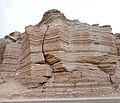Top Qs
Timeline
Chat
Perspective
Summerville Formation
Geologic formation in Four Corners region, US From Wikipedia, the free encyclopedia
Remove ads
The Summerville Formation is a geological formation in New Mexico, Colorado, and Utah of the Southwestern United States. It dates back to the Oxfordian stage of the Late Jurassic.[1]
Remove ads
Description
Summarize
Perspective
The formation consists of up to 100 meters (330 ft) of red mudstone, with thin interbeds of green and red sandstone. The lower portion of the formation shows polygonal desiccation cracks and localized salt-hopper casts while the upper portion contains considerable gypsum, consistent with deposition in a sabkha on the margin of the Sundance Sea.It is exposed in the San Rafael Reef, the Waterpocket Fold, in the Henry Mountains, with additional exposures scattered across the region from the San Rafael Reef to the Paradox Basin,[2] and in north-central New Mexico.[3] The thin bedding is characteristic throughout the formation, but gypsum is not found in the San Juan Basin and some conglomerate is found on the south and southwestern margins of the formation.[4] The correlation of late Jurassic beds in northwestern New Mexico with the Summerville Formation in Utah has been questioned, and it has been suggested that they be assigned to the Beclabito Formation instead.[5]
The Summerville Formation rests conformably on the underlying Curtis Formation (Utah and western Colorado) or Todilto Formation (southwest Colorado and New Mexico) but is separated from the overlying Morrison Formation by the regional J5 unconformity.[1] It thins significantly in the Moab-La Sal area, the likely area of the divide between the marine Curtis basin to the northwest and the salina lake Todilto basin to the southeast. Here the formation is just 1.2 meters (3.9 feet) thick and rests directly on Entrada Sandstone. In many locations the Summerville is separated from the Morrison by eolian sandstones, such as the Bluff Sandstone, variously assigned to the Morrison Formation or the San Rafael Group. The Morrison Formation represents a return to more humid conditions with increased clastic input.[6]
The Bell Ranch Formation of northeastern New Mexico is correlative with the Summerville Formation.[7]
The Summerville Formation is interpreted as recording a regression of the Sundance Sea to the north, with simultaneous infilling of both the Curtis and Todilto basins. This produced a depositional environment of very low relief, in which occasional encroachments of eolian sand during times of drought were subsequently worked into thin strata by wave action in ephemeral saline lakes.[6]
- Evenly bedded Summerville Formation exposed along Utah Highway 24, 2.4 miles west of Hanksville, Utah
- Closeup of the Summerville Formation showing even bedding, 2.4 miles west of Hanksville, Utah.
- Summerville Formation with gypsum-filled cracks. U.S. quarter dollar (24 mm) for scale
Remove ads
Fossil content
Summarize
Perspective
The formation is almost completely lacking in body fossils.[8] However, theropod tracks were found in the formation in Utah, New Mexico, and Colorado.[9]
Avemetatarsalians
Color key
|
Notes Uncertain or tentative taxa are in small text; |
Remove ads
History of investigation
The formation was first defined in 1928 for exposures in the San Rafael Reef.[2] Similar beds in northeastern Arizona and the San Juan Basin are assigned to the Wanakah Formation,[11] but continue to be assigned to the Summerville Formation in north-central New Mexico.[7][3]
See also
Wikimedia Commons has media related to Summerville Formation.
Footnotes
References
Wikiwand - on
Seamless Wikipedia browsing. On steroids.
Remove ads





